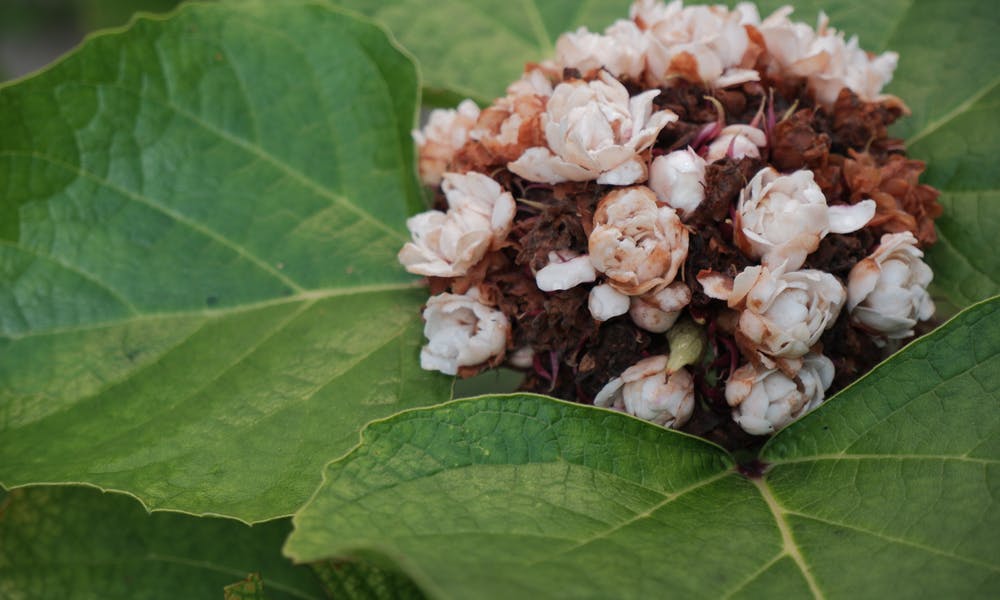Hydrangeas were first discovered in Japan. Hydrangea gets its genus name from the Greek word ‘hydor,’ meaning water. The term ‘angos’ refers to a jar or vessel. Therefore, the name hydrangea translates roughly to “a water vessel”, for its need for plenty of water.
Hydrangeas are popular flowers not just for gardens and landscapes but for florists as well. Commonly seen in wedding bouquets and decorations, these blooms have a showy effect. There are some obvious, and some not so obvious differences to help you identify certain hydrangea types you come across or would like to add to your next event. The color of the hydrangea blooms greatly depends on the soil it is being grown in. The colors range from blue to purple to pink. The more acidic the soil is, the bluer the flowers. This tends to be the case for all varieties, though, there are some exceptions. Changing the color of your blooms is something any home gardener is capable of.
Depending on your location, climate, and variety of hydrangea, they do die back during colder parts of the year dropping their foliage. New leaves emerge where old leaves have dropped and new blooms show up on juvenile wooded stems. This makes pruning important for showy hydrangeas.
The first step in identifying a hydrangea variety is to check if it is a climbing vine or a shrub. That is the easy part as there is one vine variety. After that, it is a little trickier. One must look at the details of the flowers, leaves, and stems to identify the correct hydrangea.
Today, in this article, we are going to discuss different types of hydrangeas including the following:
* Macrophylla
* Panicle
* Arborescens
* Quercifolia
* Petiolaris
* Macrophylla
Macrophylla
The deciduous shrub, Macrophylla Hydrangea, has various other names; the most common being big leaf hydrangea. This is because Macrophylla translates to ‘big-leaf’ or large. Within the Macrophylla group are subgroups, which provide more specific details on hydrangea varieties. Sometimes, it is also called French or Japanese hydrangea. Depending on the variety of Macrophylla, it can often be called snowball hydrangea due to the shape of the blooms. However, other varieties have flatter blooms, making it important to be specific when identifying a hydrangea. Since Macrophylla is grown in landscapes and gardens as well as used in floral arrangements, it is also known as florists’ hydrangea. The Macrophylla Hydrangea is the most common in the United States and there are three different varieties.
The three varieties or Macrophylla Hydrangeas are:
* Mophead, being the most popular, is easily recognizable by their flower heads. They are large heads, which can be purple, blue, and pink. The leaves also assist when identifying a mophead hydrangea. Generally, heart-shaped, the leaves have coarsely toothed edges. Being somewhat shiny, the leaves are thick and sturdy. The mophead usually grows to be four to six feet long and three to five feet wide. However, this variety does have the ability to grow smaller. The smaller kind has a shorter petiole, which means the leaves stay closer to the red-speckled stems.
* Lacecap grows almost identical to the mopheads. The biggest difference is the flowers. The lacecap blooms are flatter than the mophead. The blooms on the lacecap resemble the look of a disc with frilly edges. Most say the flowers are showier. This could be why it is the most common variety of hydrangea found in gardens. It is showy yet easy to maintain, blooming throughout the summer. The fertile flowers are the center of the buds, whereas the sterile flowers are the larger blossoms at the outer edge.
* The mountain hydrangea is the least common hydrangea of the big leaf group. The plant itself is much hardier than the rest. It survives harsh winters are climates. However, the flowers are much smaller. They are more similar to the lacecap flowers in that smaller flowers in the center are surrounded by bigger flowers. The shrub itself is more compact.
Paniculata
Also known as panicled hydrangea, this variety has cone-shaped blooms. It is a large variety that grows over 10 feet tall if allowed. It is easy to identify as it has three, small, rough leaves that grow from a stem node. The edges not as coarsely toothed as the other varieties. This is also the only variety that will grow as a tree. Prune the plant to develop a thick trunk. Being that this variety can grow in all areas of the United States where it doesn’t freeze, it is a popular variety for gardens.
Arborescens
Most commonly known as the smooth hydrangea or wild hydrangea, this variety is unable to change its bloom color with acidity. This shrub is native to the United States and can be found near moist areas such as ravines and streambanks. The Arborescens tolerates hotter climates and is generally planted in hedges. Identify this variety by the thin, heart-shaped leaves being floppier than the mophead and lacecap. The stems of the leaf are longer and are held further away from the main stem than other varieties. The leaves also are matte texture, unlike most other varieties.
Quercifolia
The Quercifolia is most commonly known as the oakleaf hydrangea. As the name suggests, the leaves on the oakleaf hydrangea are shaped like those of the red oak. The size varies and can be as small as 4 or 10 inches. The Quercifolia has foliage that changes in the fall. It is the only hydrangea variety to do so. Find this kind of hydrangea near moist woods and stream banks as it prefers moist soil.
Petiolaris
This variety is the easiest to spot. Also known as the climbing hydrangea, it is a vine. Being native to Japan and Korea, this variety is gaining popularity in other places as well due to the uniqueness of its growth habit. The climbing hydrangea has reached 80 feet, so pruning is essential to keep it contained.
